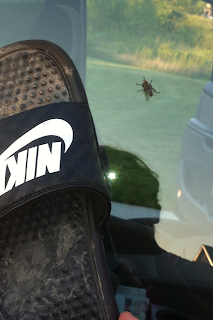Homeostasis (Number 22)
I took my temperature and got exactly 98.6 degrees, which is homeostasis. In humans, homeostasis happens when the body regulates body temperature in an effort to maintain an internal temperature around 98.6 degrees Fahrenheit. But, in an organism/cell its internal conditions, usually by a system of feedback controls, stabilizes health and functioning, regardless of the outside changing conditions.
Pollinator (Number 23)
This fly is a pollinator because it is an insect that carries pollen to another flower. A pollinator is the agent that moves pollen from the male anthers of a flower to the female stigma of a flower to accomplish fertilization or syngamy of the female gamete in the ovule of the flower by the male gamete from the pollen grain.
Asexual Reproduction (Number 24)
This onion bulb is apart of asexual reproduction because is able to produce offspring in the absence of a mate.
Seed Dispersal (Wind) (Number 25)
This is seed dispersal because the wind is carrying the pollen in the air.
Pollinator (Number 26)
The bees on the beehive, shown in the picture is a pollinator because it is an insect that carries pollen to another flower. (Another pollinatoris shown in Number 23)
Seed Dispersal (Water) (Number 27)
The water lillies are dispersed throughout the water, as shown in the picture.
Pollen (Number 28)
The pollen from the lily is shown on the napkin. We rubbed it off to show what the pollen looks like.
Niche (Number 29)
In this picture is a woodchuck hole and is shown to be a niche. A niche is the specific area where an organism inhabits, just like this woodchuck.
Lichen (Number 30)
The lichen is shown to be the moss-like substance growing on the tree.
Lichen is a simple plant consisting of a fungus, just like this tree.
Unicellular Organism (Number 31)
Amoeba is a genus of Protozoa consisting of shapeless unicellular organisms, shown in the pond water here.
Epithelial Tissue (Number 32)
The epithelial tissue is the tissue inside of my cheek.
Introduced Species (Number 33)
These purple flowers are introduced species because they are non- native.
Bilateral Symmetry (Number 34)
This grasshopper has bilateral symmetry because both halves are equal.
Population (Number 35)
This picture is a population of trees/plants/weeds. Population is defined as the same species in one area.
Fermentation (Number 36)
Fermentation occurs naturally but humans have used and controlled the process. It is used in the production of alcohol, bread, vinegar, and other food or industrial products.
Lipid Used for Energy Storage (Number 37)
This is a picture of lard, which is a lipid used for energy storage.
Bilateral Symmtery (Number 38)
This leaf has bilateral symmtery becuase both halves are equal.

















No comments:
Post a Comment
Note: Only a member of this blog may post a comment.